
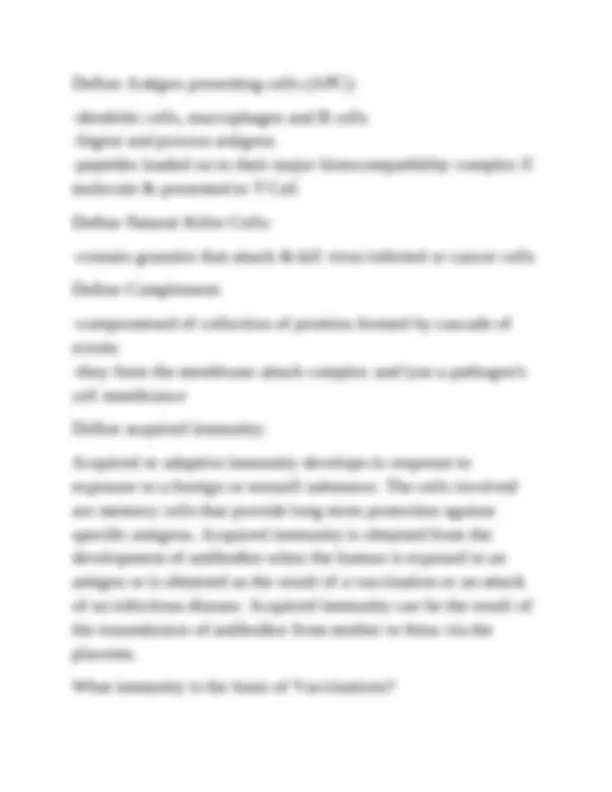
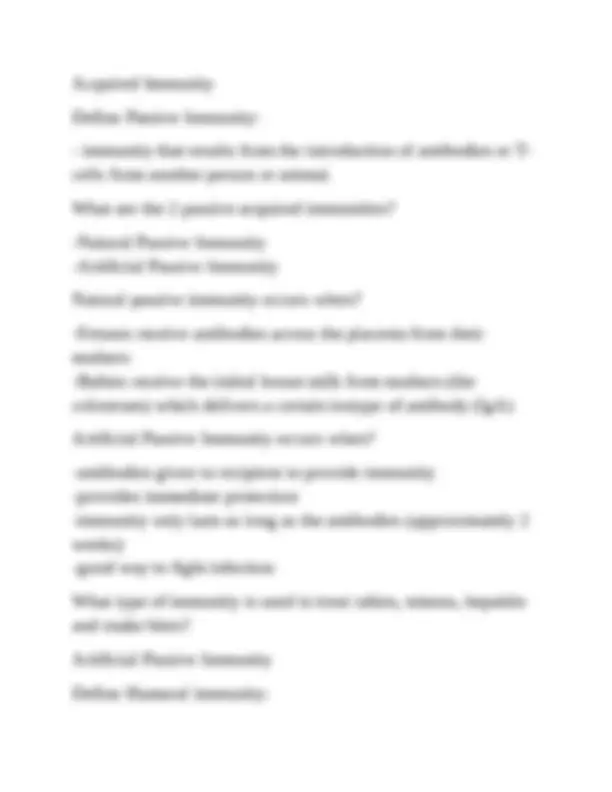
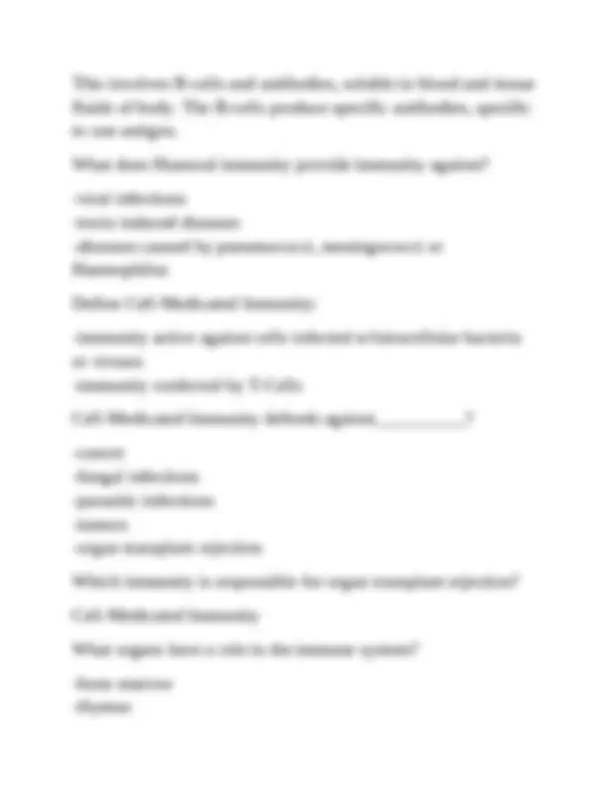
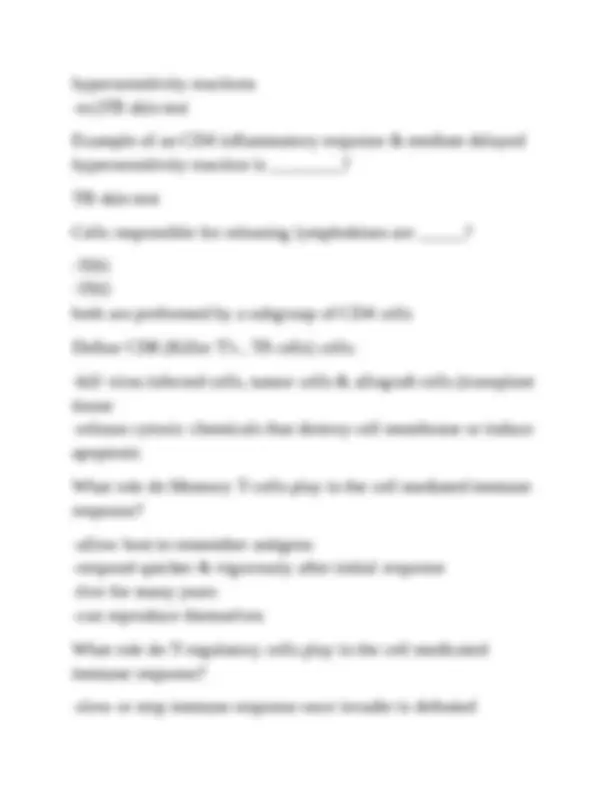
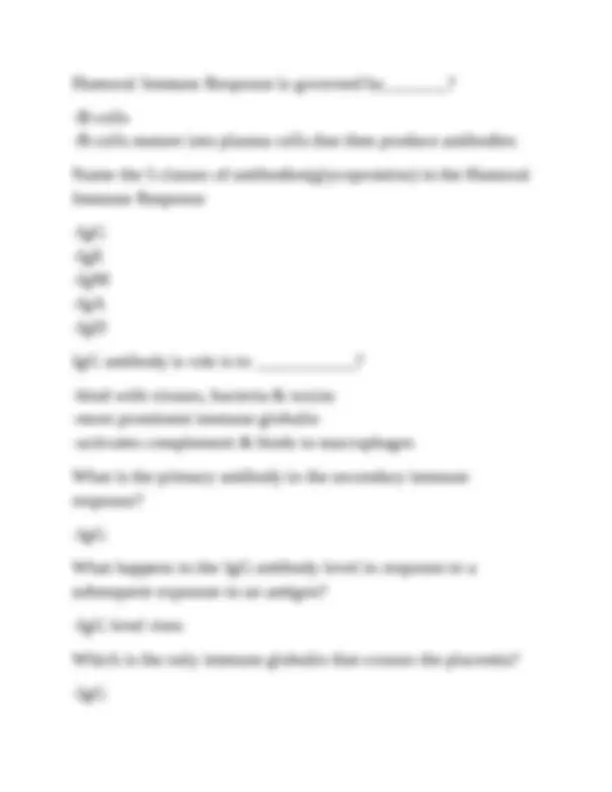
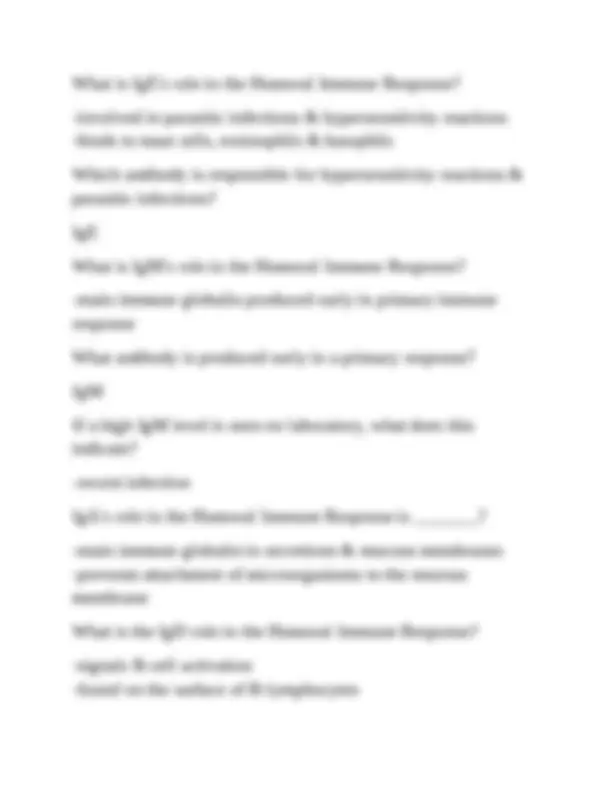
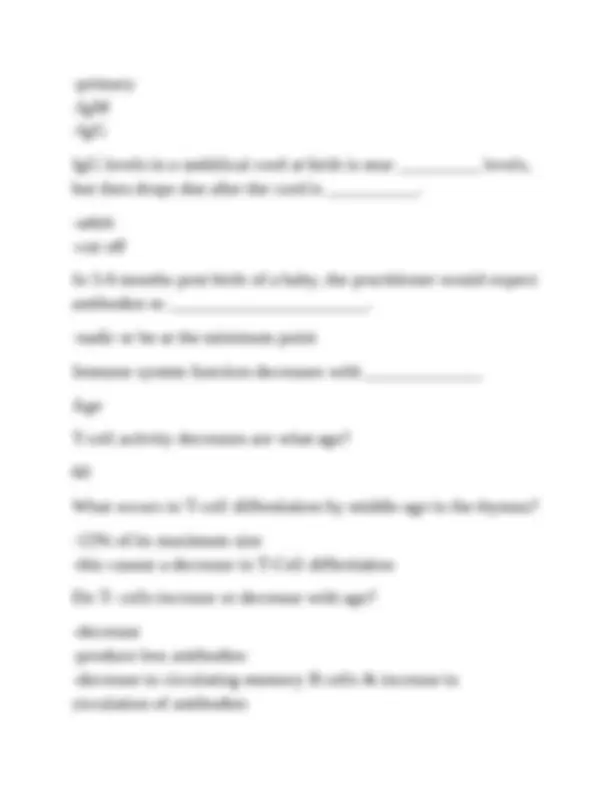
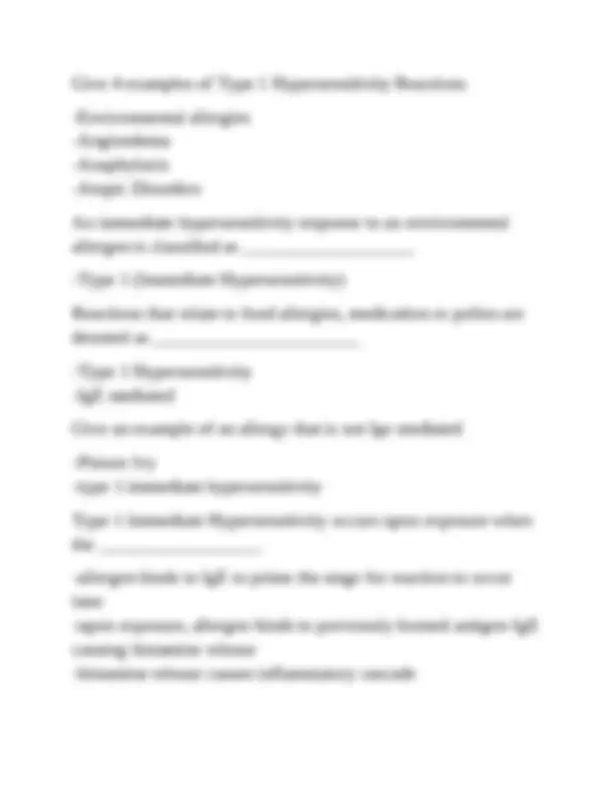
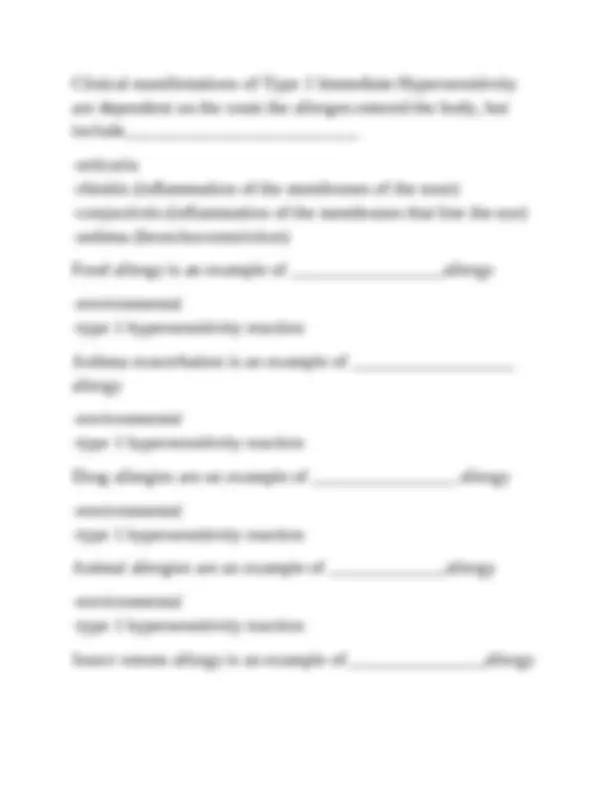
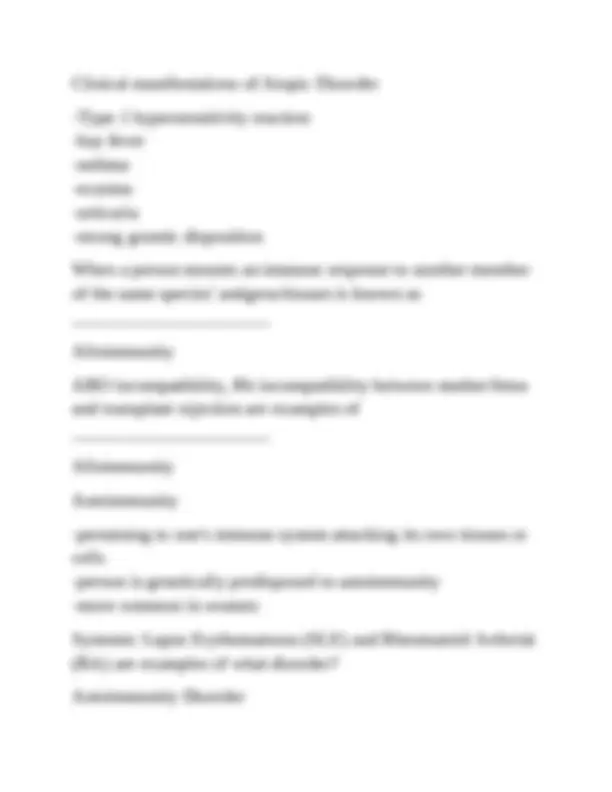
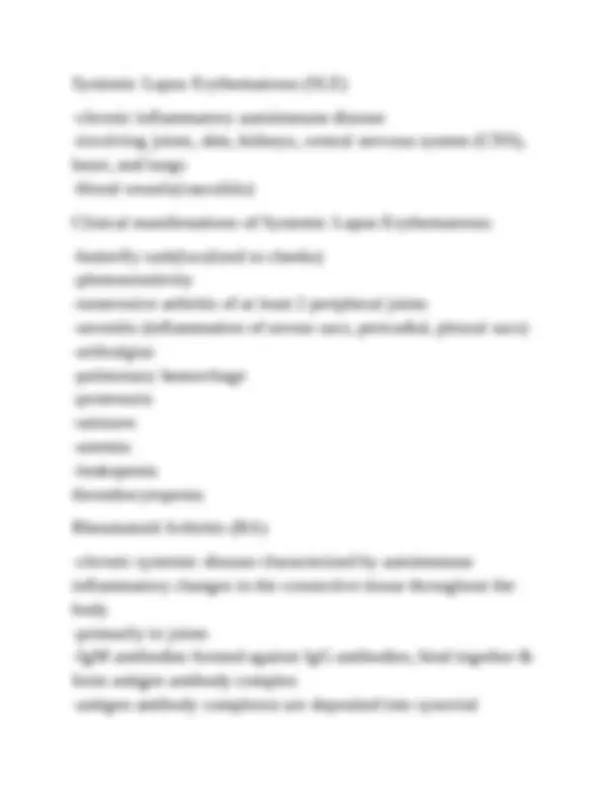
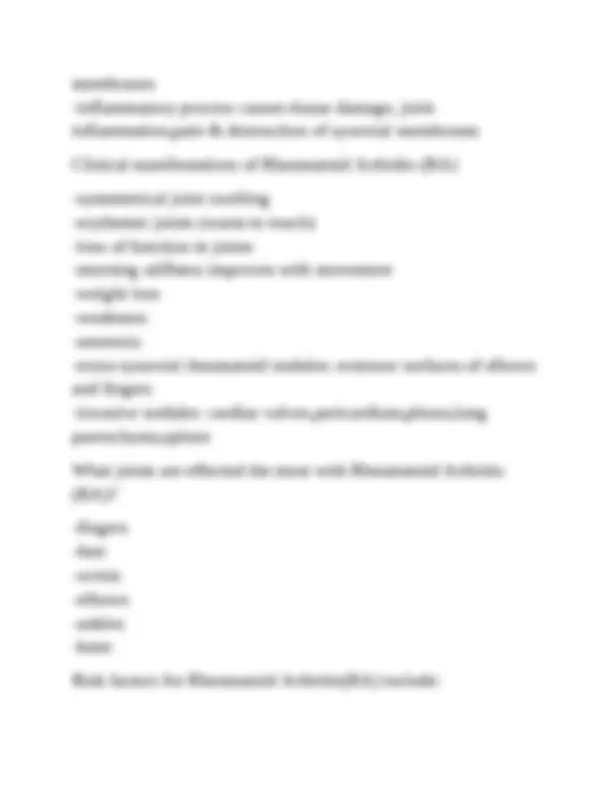
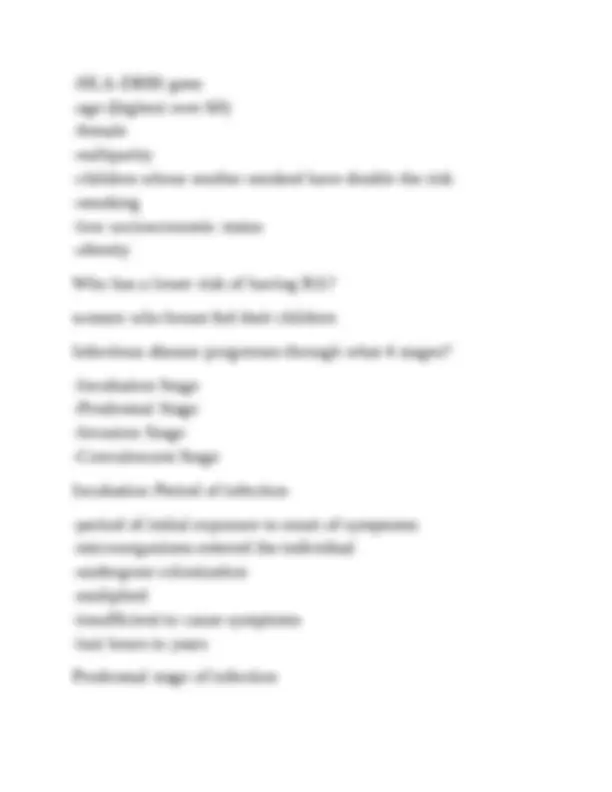
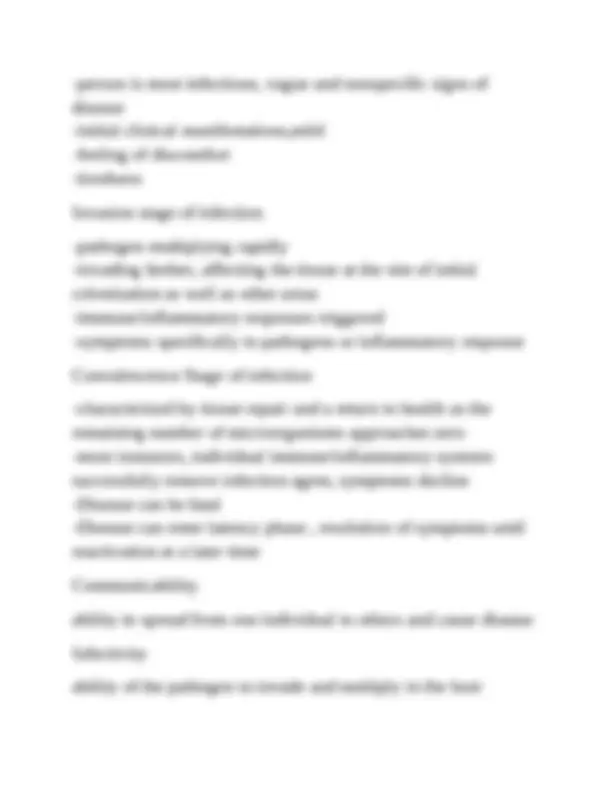
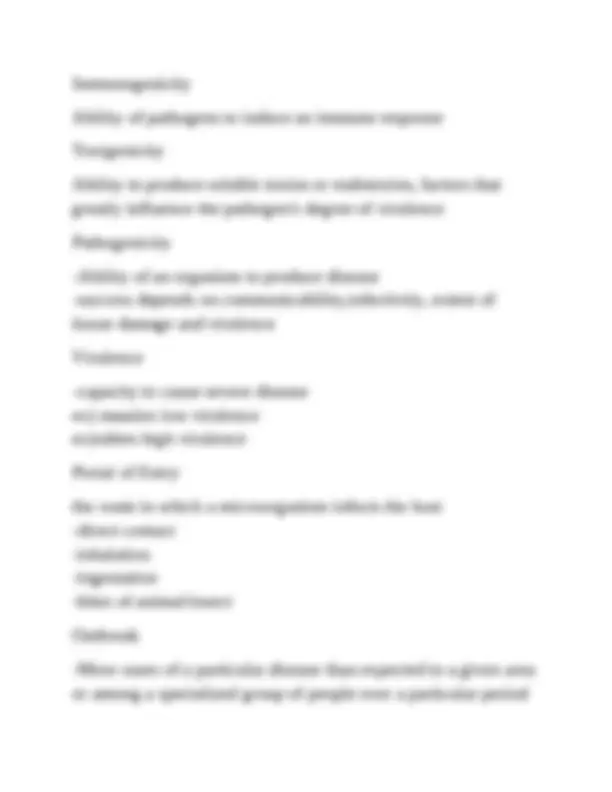
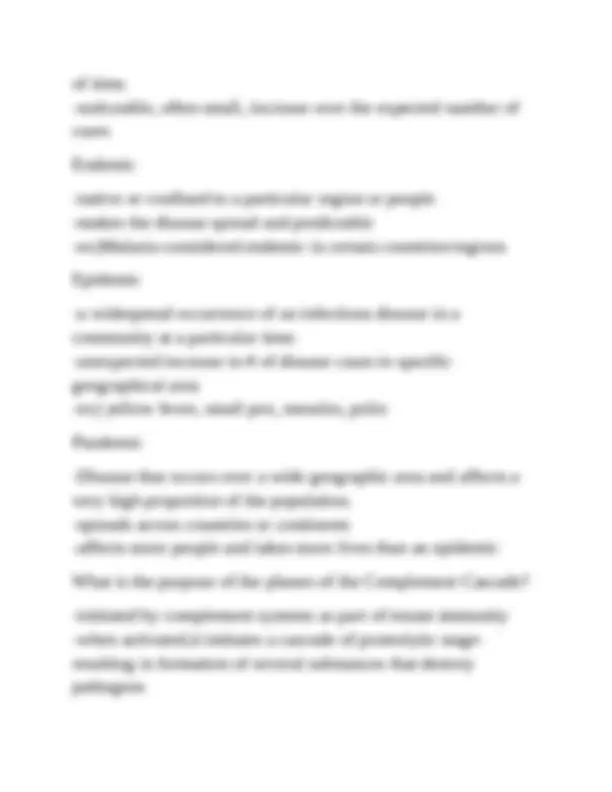
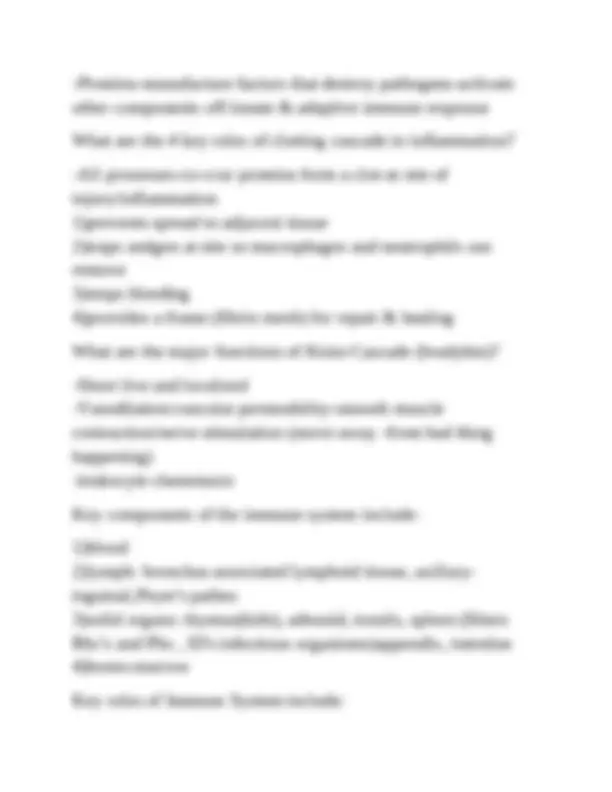
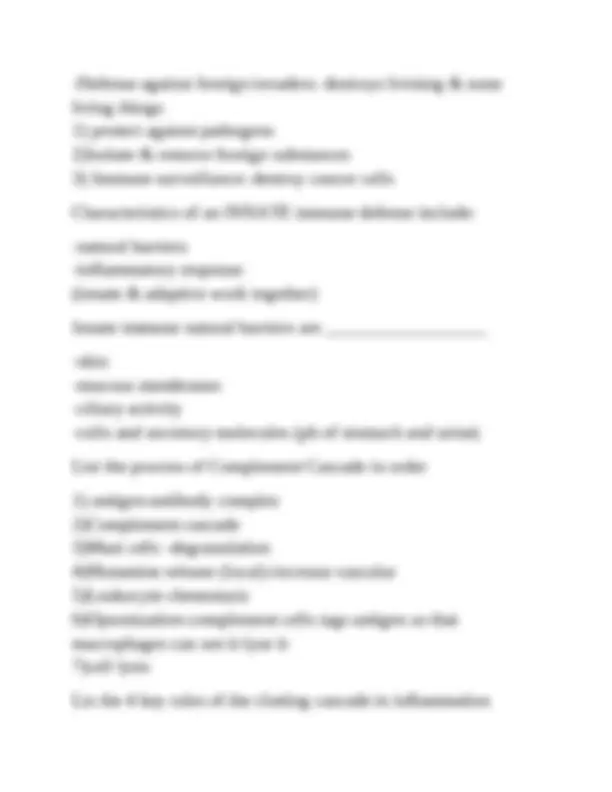
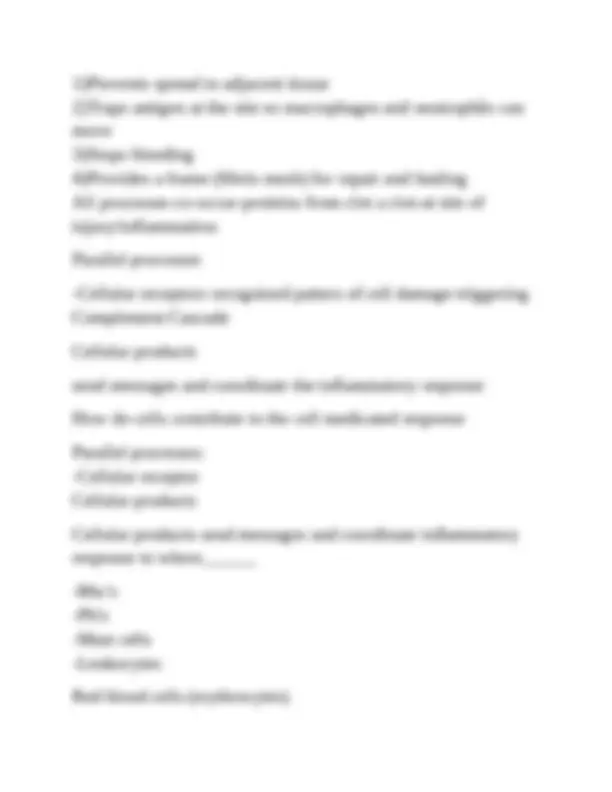
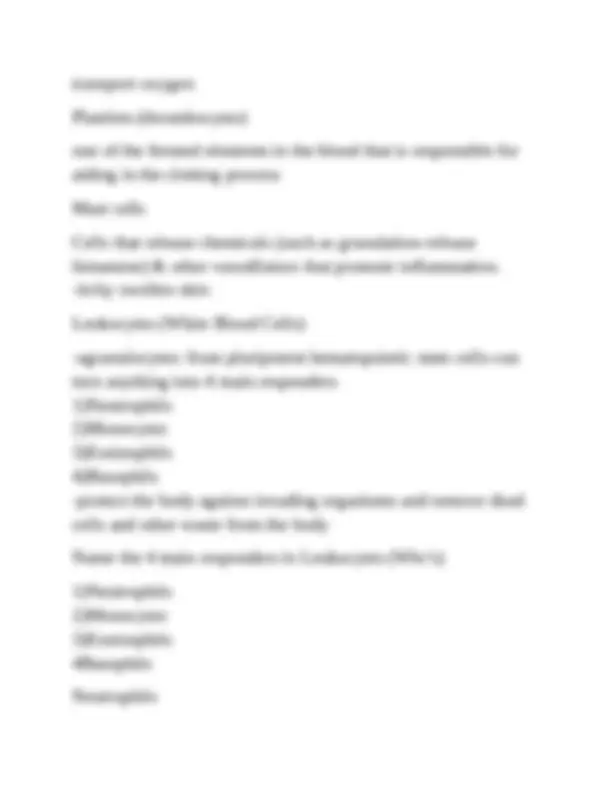
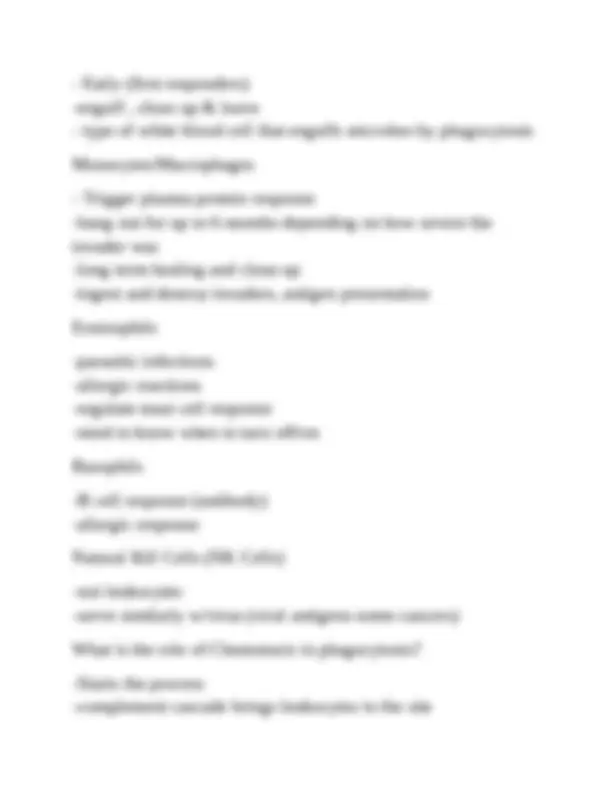
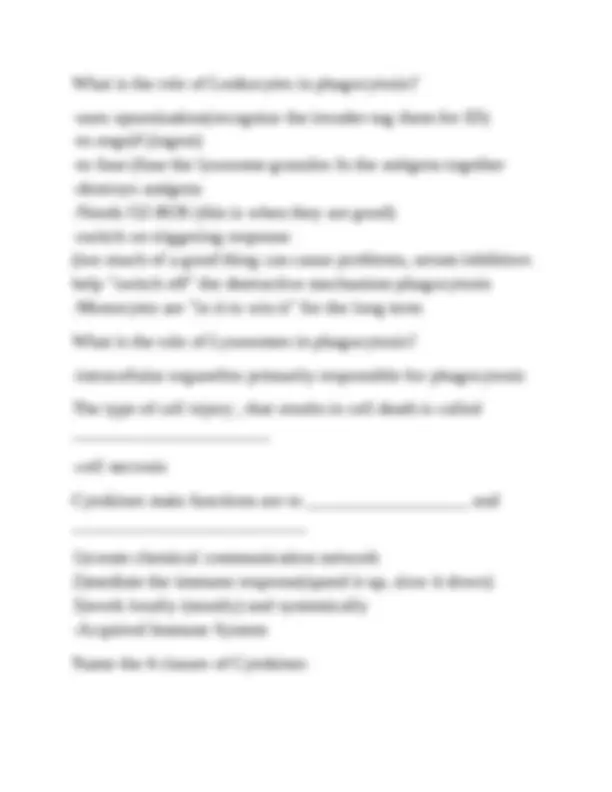
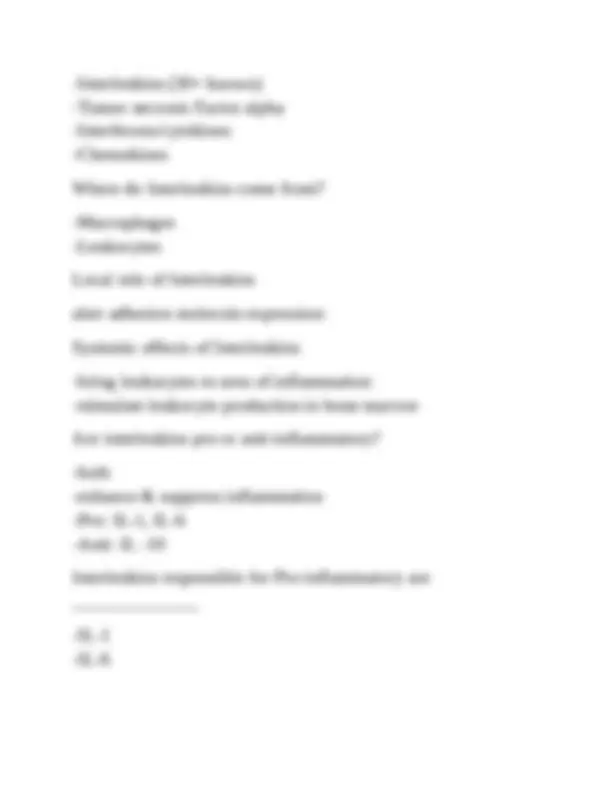
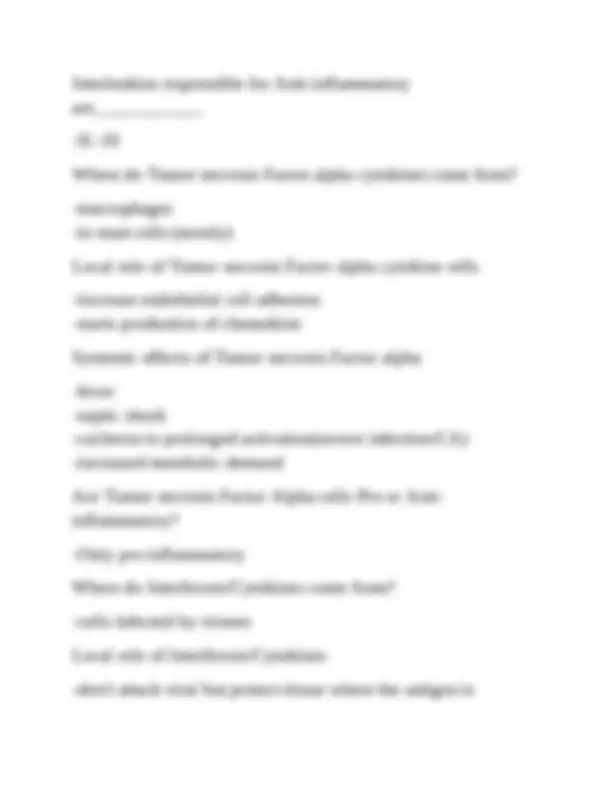
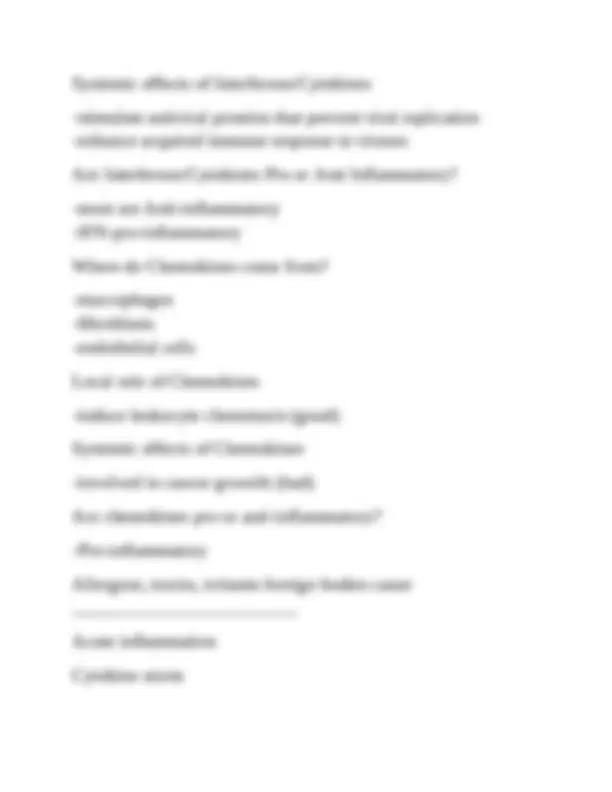
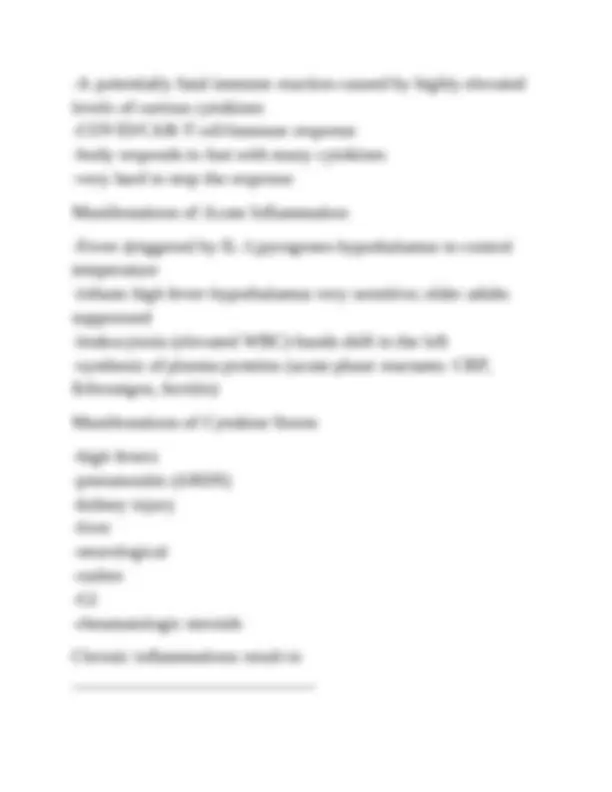
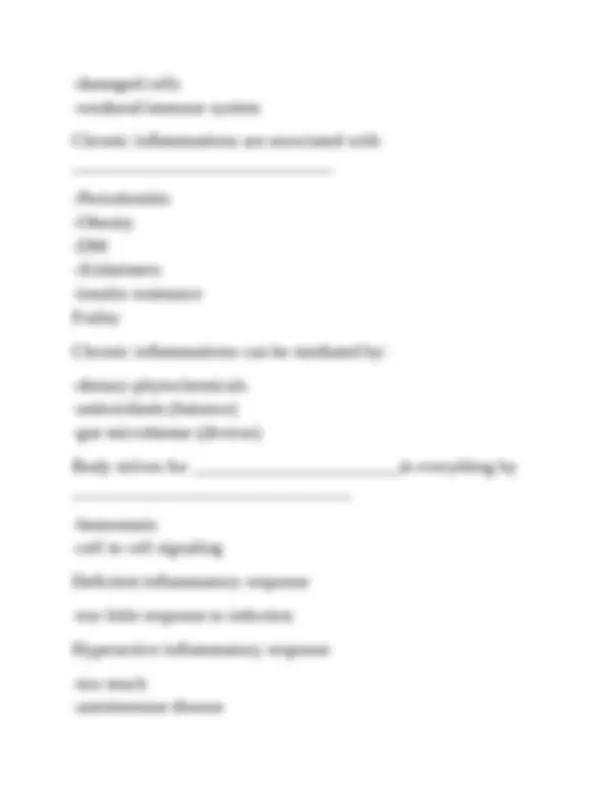
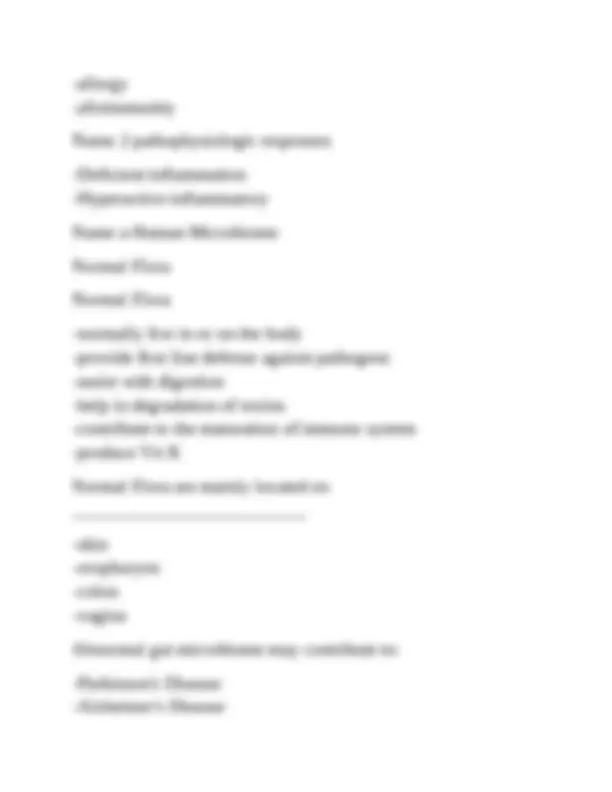
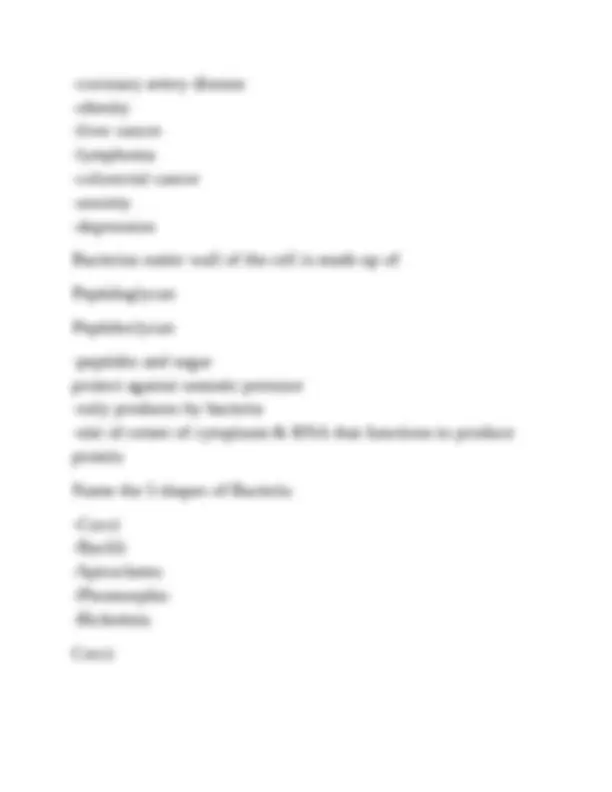
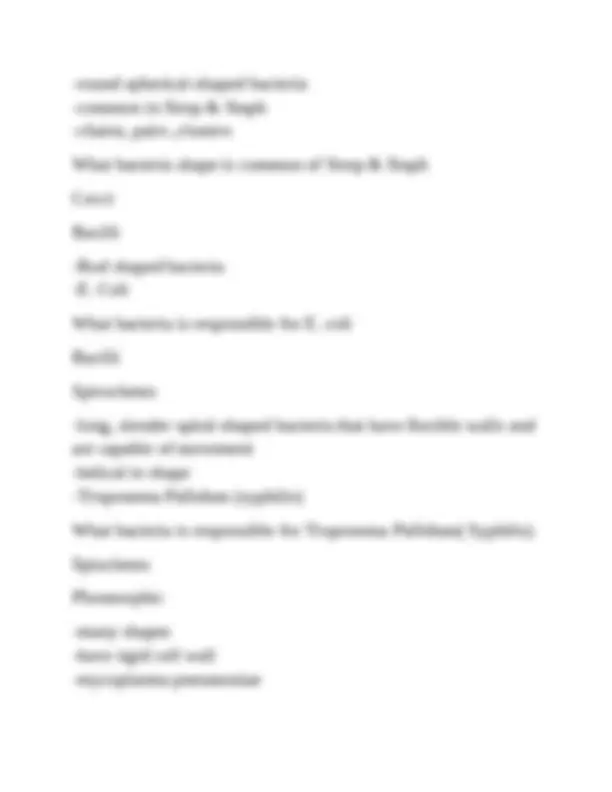
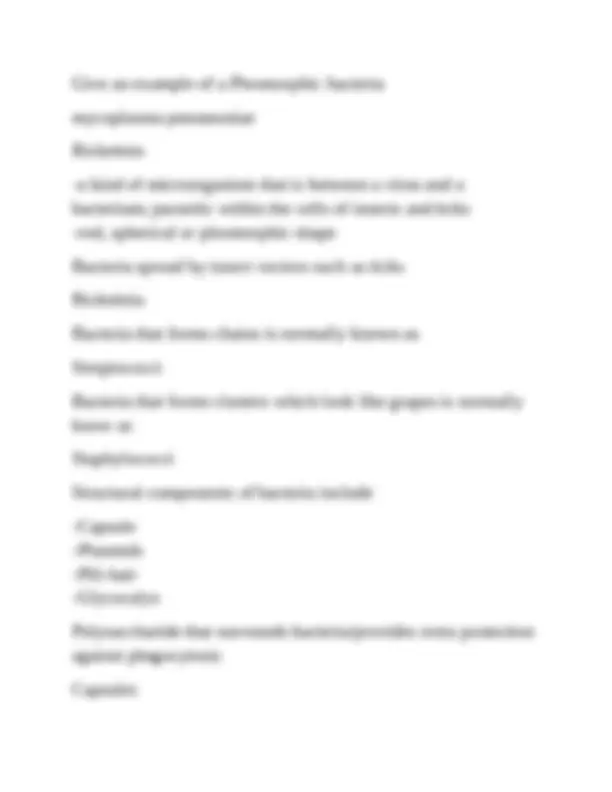
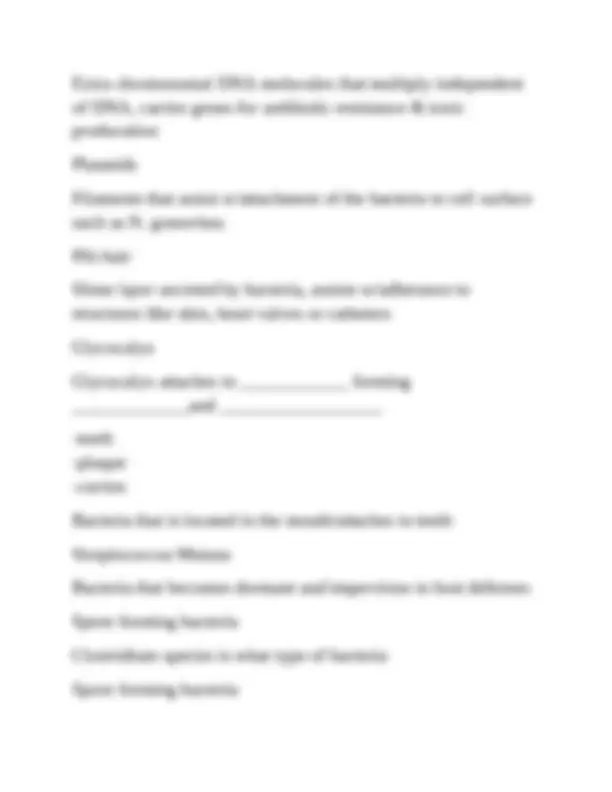
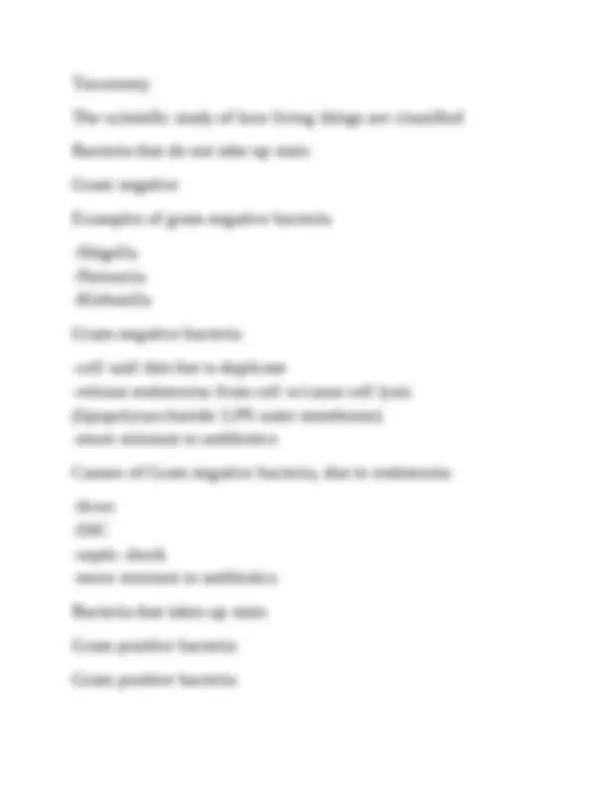
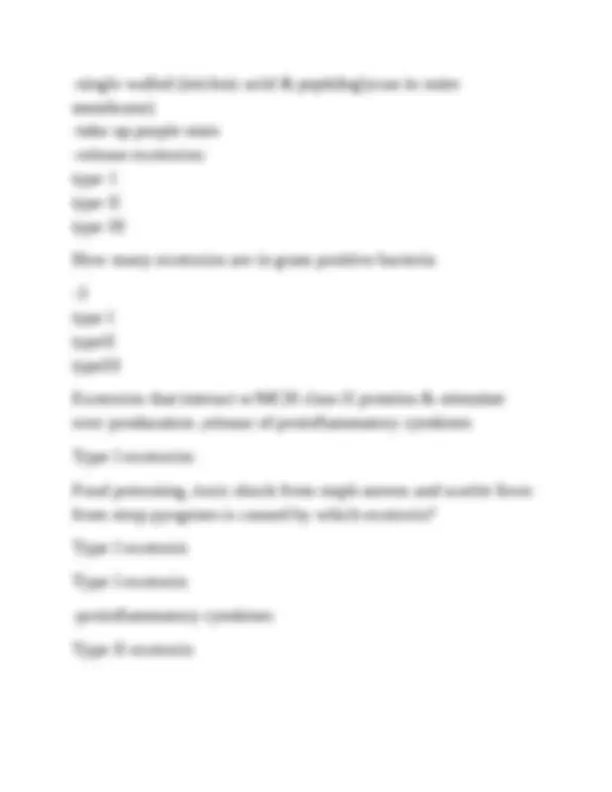
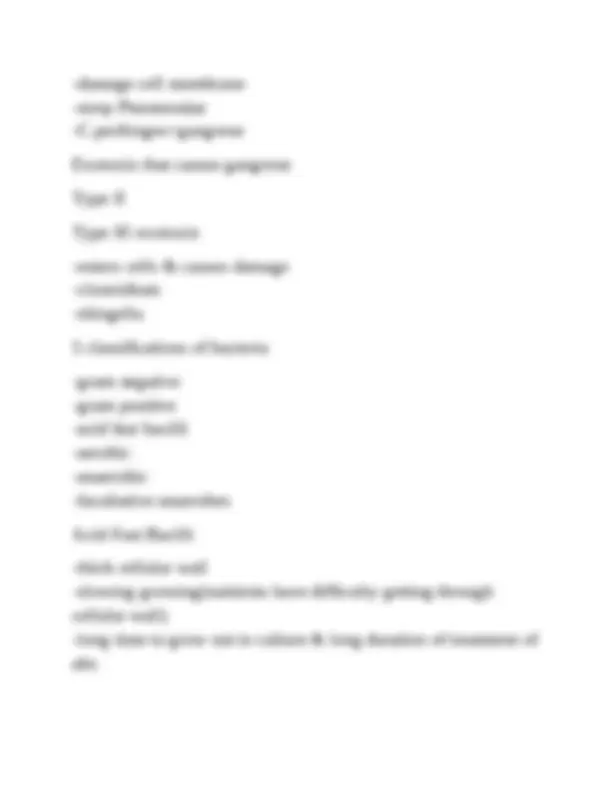
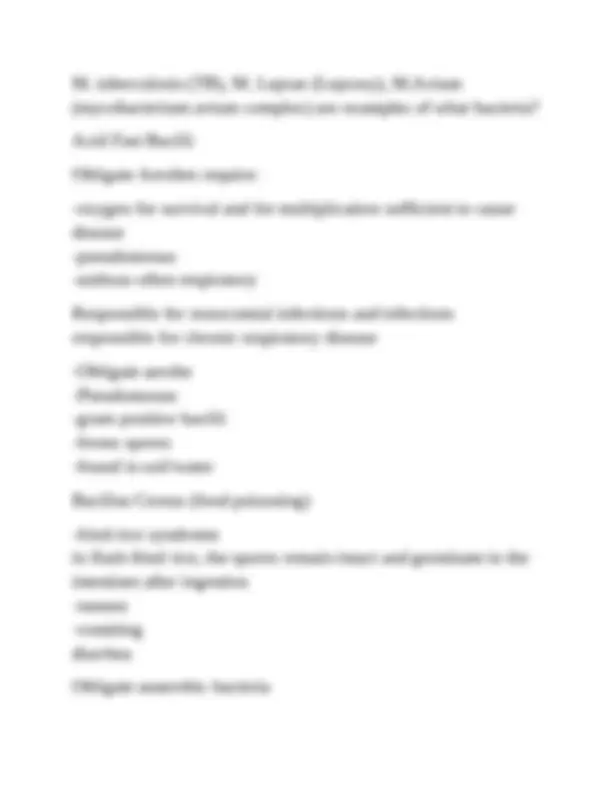
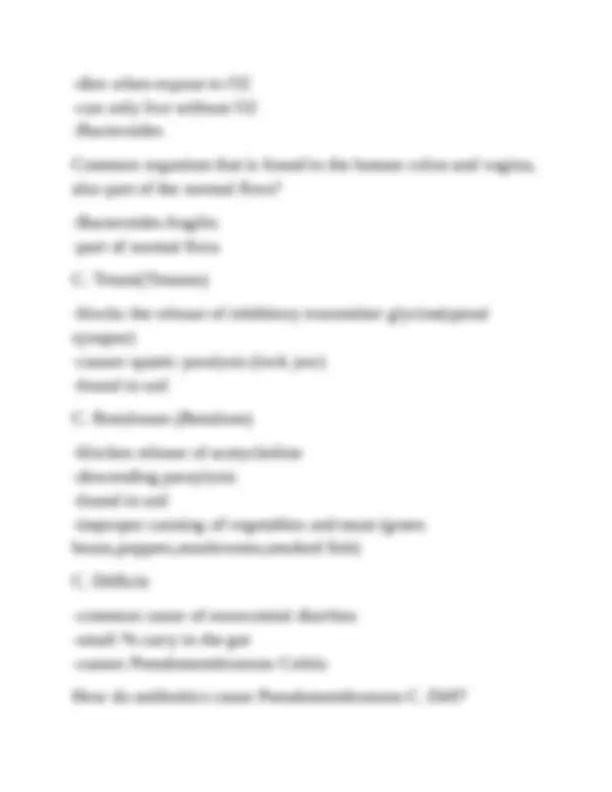
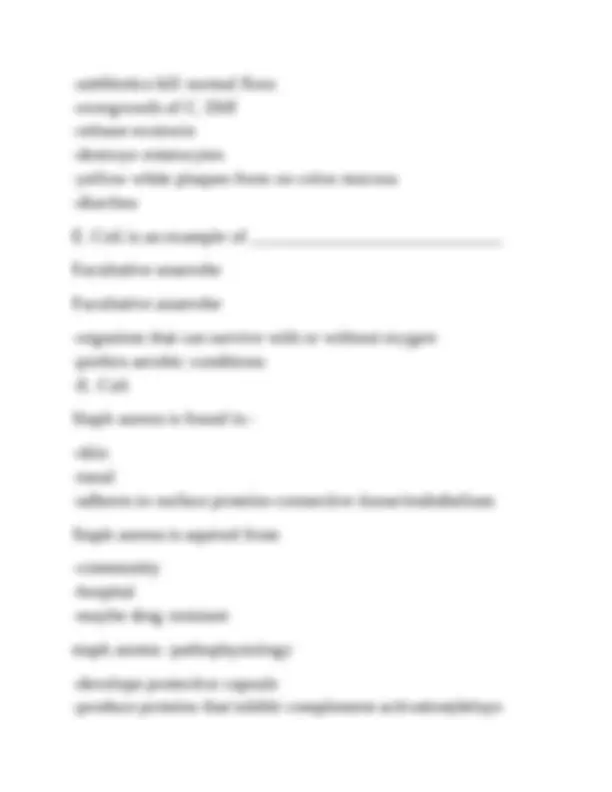
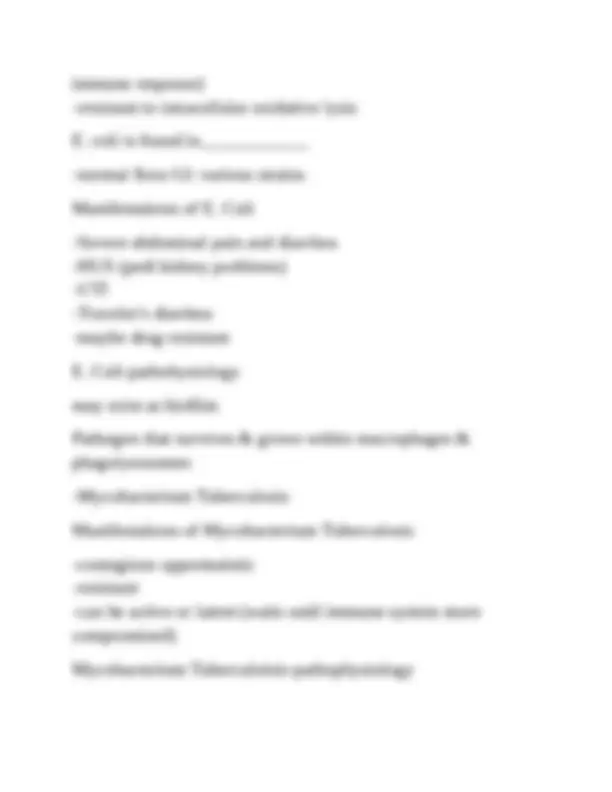
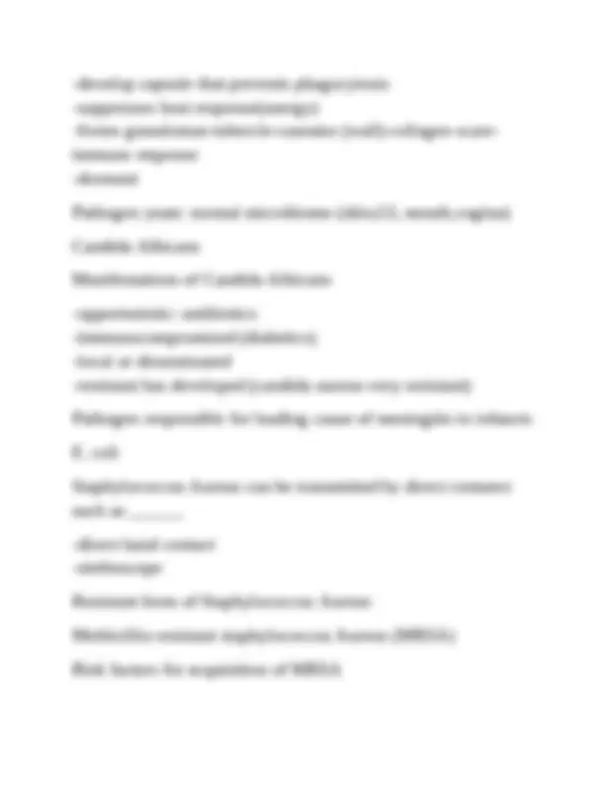
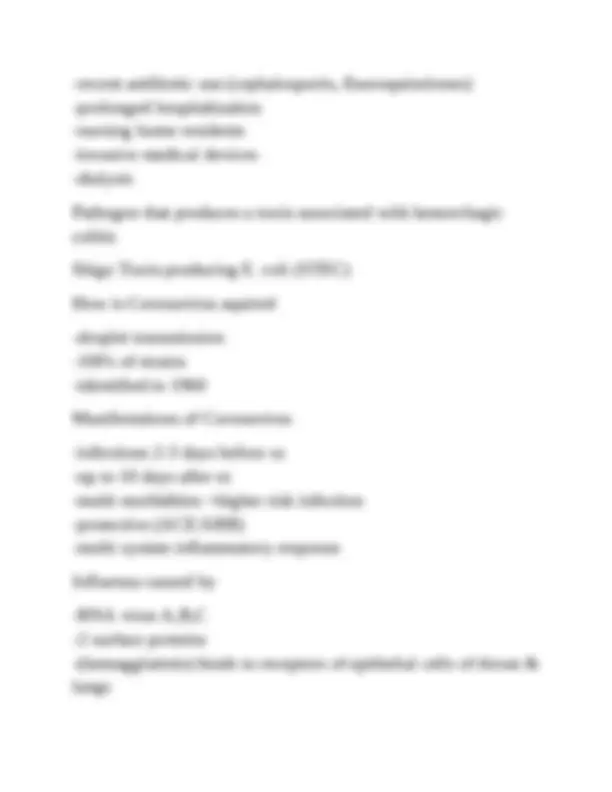
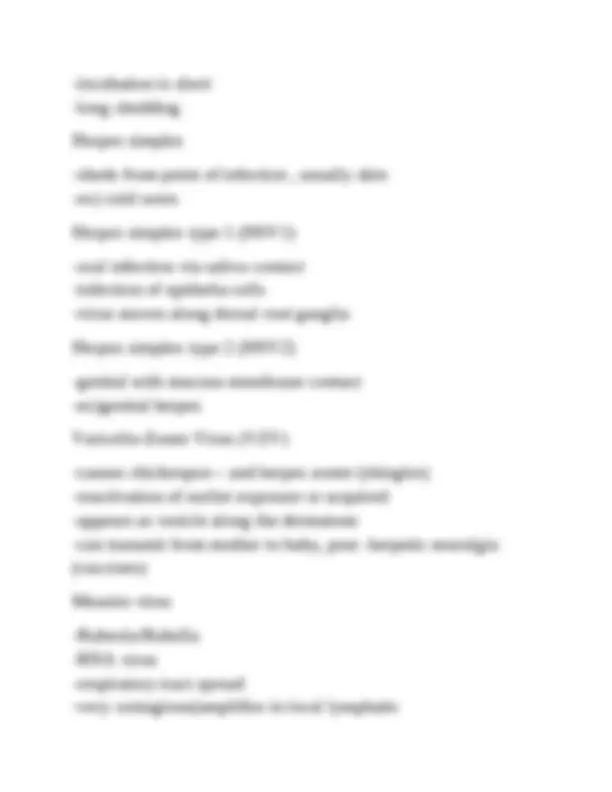
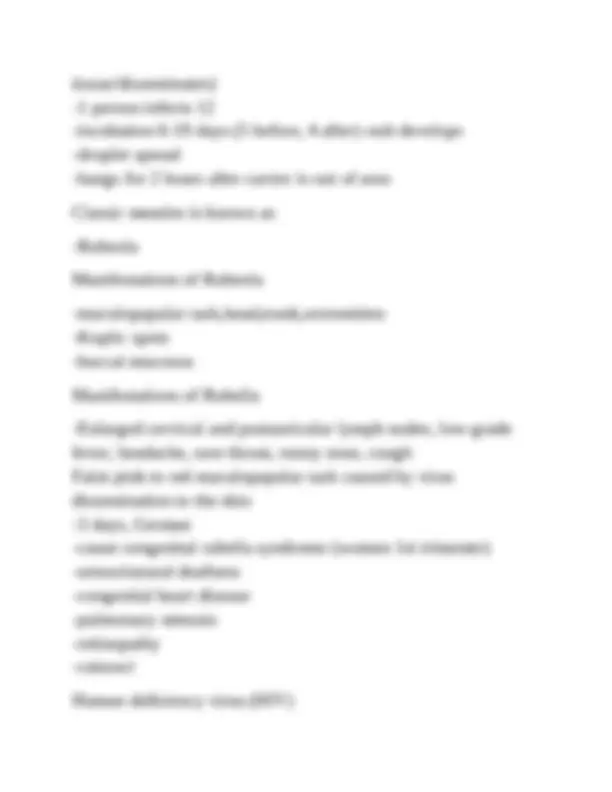
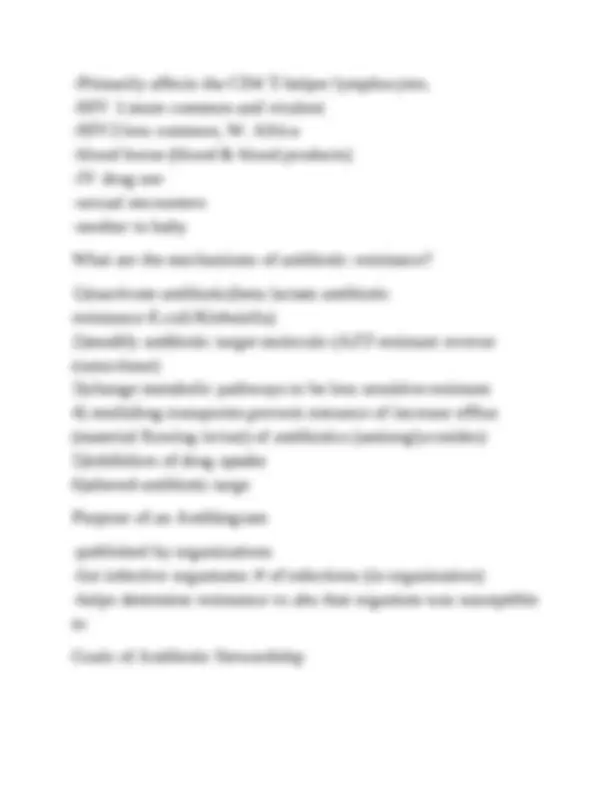
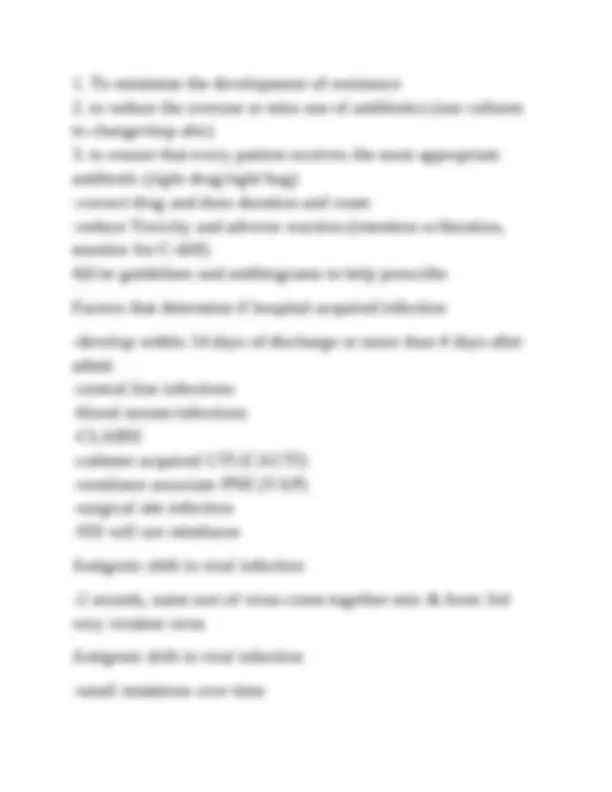
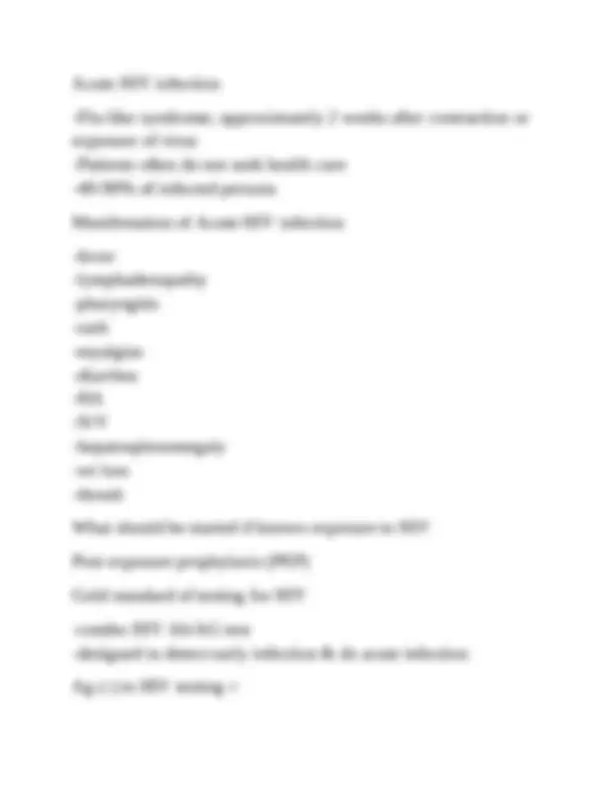
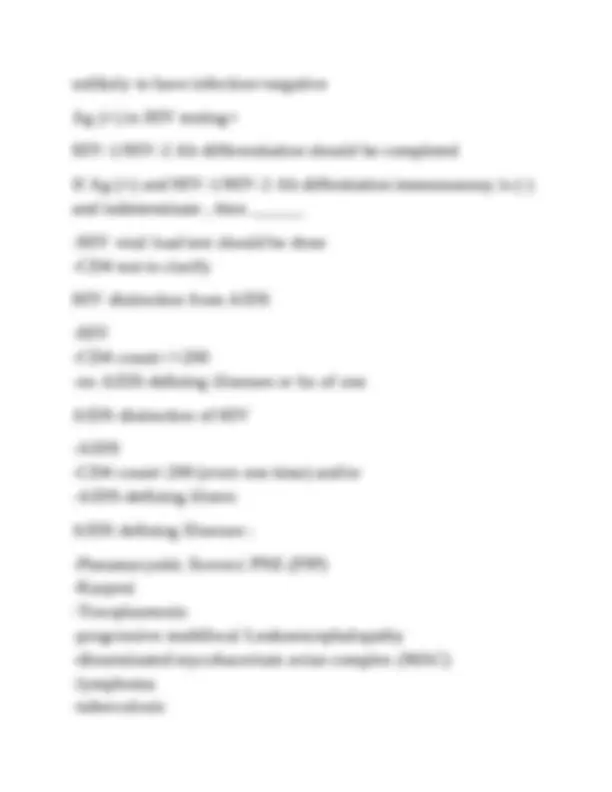
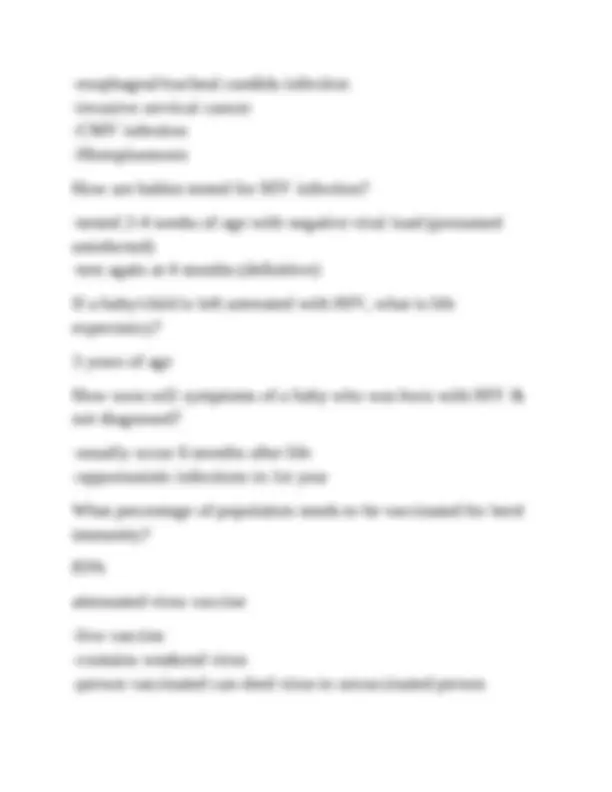



Study with the several resources on Docsity

Earn points by helping other students or get them with a premium plan


Prepare for your exams
Study with the several resources on Docsity

Earn points to download
Earn points by helping other students or get them with a premium plan
Community
Ask the community for help and clear up your study doubts
Discover the best universities in your country according to Docsity users
Free resources
Download our free guides on studying techniques, anxiety management strategies, and thesis advice from Docsity tutors
A comprehensive overview of the different types of immunity, including innate, acquired, passive, humoral, and cell-mediated immunity. It delves into the roles of various immune cells, such as neutrophils, macrophages, dendritic cells, and natural killer cells, and explains the mechanisms of antibody production and the complement cascade. The document also explores the functions of different organs involved in the immune system, such as the bone marrow, thymus, spleen, and lymph nodes. It concludes with a discussion of the primary and secondary immune responses and their implications for disease prevention and treatment.
Typology: Exams
1 / 57

This page cannot be seen from the preview
Don't miss anything!


















































What are the 5 types of Immunity? -Natural Immunity (Innate Resistance/Immunity) -Acquired Immunity -Passive Acquired Immunity -Humoral Immunity -Cell-Mediated Immunity Define Natural Immunity (Innate Resistance/Immunity): -resistance that exist prior to exposure to a microbe -we are born with this resistance -based on genotypes and species What nonspecific barriers to infection does Natural Immunity provide? -skin -mucous membranes -certain cells (NK cells) -certain proteins (complement cytokines) -inflammation -phagocytosis -does not improve at exposure
-functions to kill invading microorganisms and activates acquired immunity Name the cells of innate immunity? -phagocytic cells -antigen presenting cells -natural killer cells -complement Define Phagocytic cells: -cell of innate immunity (Natural Immunity or Innate Resistance/Immunity) -includes: Neutrophils, Macrophages, Dendritic Cells Define Neutrophils: -present during acute inflammation -responsible for engulfing microbes & kills them by using cytoplasmic myeloperoxidase Cytoplasmic Myeloperoxidase is toxic to? Pathogens Define Macrophages: -derived from monocytes, which leave the blood stream and differentiate tissues Define Dendritic Cells: -engulf antigens in the epithelia of skin, GI and respiratory trace
Acquired Immunity Define Passive Immunity:
This involves B-cells and antibodies, soluble in blood and tissue fluids of body. The B-cells produce specific antibodies, specific to one antigen. What does Humoral immunity provide immunity against? -viral infections -toxin induced diseases -diseases caused by pneumococci, meningococci or Haemophilus Define Cell-Medicated Immunity: -immunity active against cells infected w/intracellular bacteria or viruses -immunity conferred by T-Cells Cell-Medicated Immunity defends against__________? -cancer -fungal infections -parasitic infections -tumors -organ transplant rejection Which immunity is responsible for organ transplant rejection? Cell-Medicated Immunity What organs have a role in the immune system? -bone marrow -thymus
hypersensitivity reactions -ex)TB skin test Example of an CD4 inflammatory response & mediate delayed hypersensitivity reaction is ________? TB skin test Cells responsible for releasing lymphokines are _____? -TH -TH both are preformed by a subgroup of CD4 cells Define CD8 (Killer T's , T8 cells) cells: -kill virus infected cells, tumor cells & allograft cells (transplant tissue -release cytoxic chemicals that destroy cell membrane or induce apoptosis What role do Memory T-cells play in the cell mediated immune response? -allow host to remember antigens -respond quicker & vigorously after initial response -live for many years -can reproduce themselves What role do T-regulatory cells play in the cell medicated immune response? -slow or stop immune response once invader is defeated
What is IgE's role in the Humoral Immune Response? -involved in parasitic infections & hypersensitivity reactions -binds to mast cells, eosinophils & basophils Which antibody is responsible for hypersensitivity reactions & parasitic infections? IgE What is IgM's role in the Humoral Immune Response? -main immune globulin produced early in primary immune response What antibody is produced early in a primary response? IgM If a high IgM level is seen on laboratory, what does this indicate? -recent infection IgA's role in the Humoral Immune Response is _______? -main immune globulin in secretions & mucous membranes -prevents attachment of microorganisms to the mucous membrane What is the IgD role in the Humoral Immune Response? -signals B-cell activation -found on the surface of B-lymphocytes
What activates the complement cascade? -antibodies coat the bacteria to enhance phagocytosis & form antigen antibody complexes The overall function of antibodies include_____? -neutralization of bacterial toxins, this activates the complement cascade Upon exposure to an antigen , the immune system will mount a response within ________________________ days? 5-7 days Primary immune response is characterized by a ________of ______ antibodies and later in the course of an infection a ______ of _____________ antibodies. 1)rise 2)Igm 3)rise 4)IgG A secondary immune response occurs when ____________? next time the immune system is exposed to the same antigen, this response is mounted Another term for secondary immune response is _______? Anamnestic immune response
-primary -IgM -IgG IgG levels in a umbilical cord at birth is near _________ levels, but then drops due after the cord is __________. -adult -cut off In 5-6 months post birth of a baby, the practitioner would expect antibodies to ______________________. -nadir or be at the minimum point Immune system function decreases with _____________ Age T-cell activity decreases are what age? 60 What occurs to T-cell diffentiation by middle age in the thymus? -15% of its maximum size -this causes a decrease in T-Cell differtiation Do T- cells increase or decrease with age? -decrease -produce less antibodies -decrease in circulating memory B cells & increase in circulation of antibodies
Give 4 examples of Type 1 Hypersensitivity Reactions -Environmental allergies -Angioedema -Anaphylaxis -Atopic Disorders An immediate hypersensitivity response to an environmental allergen is classified as ___________________ -Type 1 (Immediate Hypersensitivity) Reactions that relate to food allergies, medication or pollen are denoted as _______________________ -Type 1 Hypersensitivity -IgE mediated Give an example of an allergy that is not Ige mediated -Poison Ivy -type 1 immediate hypersensitivity Type 1 Immediate Hypersensitivity occurs upon exposure when the __________________ -allergen binds to IgE to prime the stage for reaction to occur later -upon exposure, allergen binds to previously formed antigen-IgE causing histamine release -histamine release causes inflammatory cascade
-environmental -type 1 hypersensitivity reaction Asthma exacerbation, food allergies, drug allergies, animal allergies, and insect venom allergies are catergorized as what type of allergy? -environmental -type 1 hypersensitivity reaction Swelling of the lips, eyes and larynx is called
-Agioedema Agioedema is considered a ____________________ and related to ___________________________. -type 1 hypersensitivity reaction -medications or may be idopathic The most know severe reaction is _______________________ Anaphylaxis Anaphylaxis occurs as a result of what type of hypersensitivity? Type 1 Hypersensitivity (Immediate Hypersensitivity) How long does it take an anaphylaxis to occur upon exposure of allergen? within minutes of exposure
Clinical manifestations of Anaphylaxis : Bronchospasm-dyspnea Laryngeal edema Inspiratory stridor-wheezing Hypotension Circulatory shock Wheal & flare reactions Flushing Pruritus Urticaria Angioedema Facial swelling N/V/D Abdominal cramps Death Anaphylaxis treatment Seek immediate medical attention
Systemic Lupus Erythematosus (SLE) -chronic inflammatory autoimmune disease -involving joints, skin, kidneys, central nervous system (CNS), heart, and lungs -blood vessels(vasculitis) Clinical manifestations of Systemic Lupus Erythematosus: -butterfly rash(localized to cheeks) -photosensitivity -nonerosive arthritis of at least 2 peripheral joints -serositis (inflammation of serous sacs, pericadial, pleural sacs) -arthralgias -pulmonary hemorrhage -protenuria -seizures -anemia -leukopenia thrombocytopenia Rheumatoid Arthritis (RA) -chronic systemic disease characterized by autoimmune inflammatory changes in the connective tissue throughout the body -primarily in joints -IgM antibodies formed against IgG antibodies, bind together & form antigen antibody complex -antigen antibody complexes are deposited into synovial
membranes -inflammatory process causes tissue damage, joint inflammation,pain & destruction of synovial membranes Clinical manifestations of Rheumatoid Arthritis (RA) -symmetrical joint swelling -erythemic joints (warm to touch) -loss of function in joints -morning stiffness improves with movement -weight loss -weakness -anorexia -extra-synovial rheumatoid nodules: extensor surfaces of elbows and fingers -invasive nodules: cardiac valves,pericardium,pleura,lung parenchyma,spleen What joints are effected the most with Rheumatoid Arthritis (RA)? -fingers -feet -wrists -elbows -ankles -knee Risk factors for Rheumatoid Arthritis(RA) include: